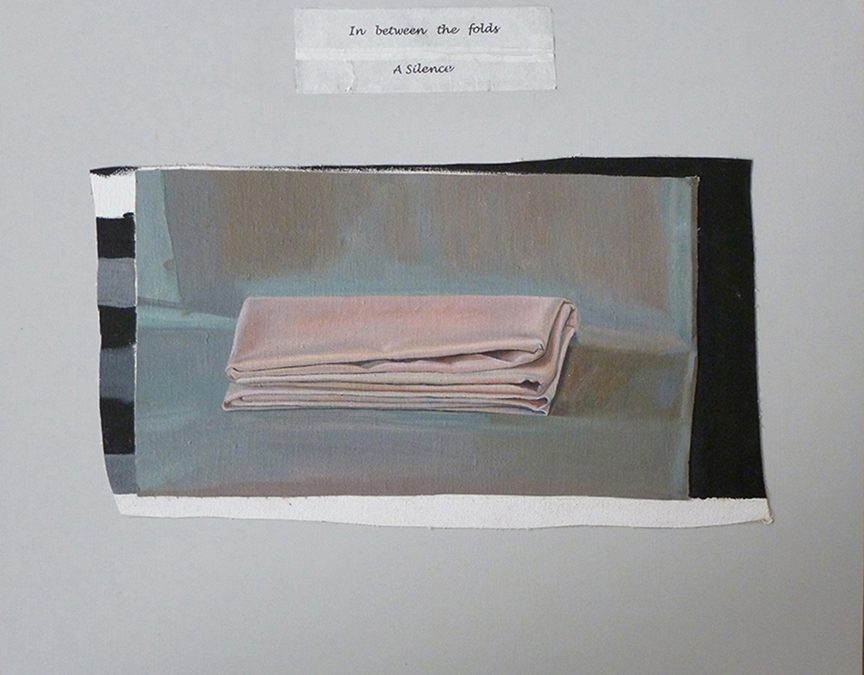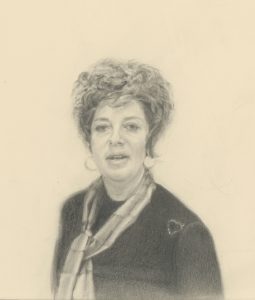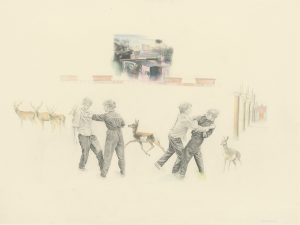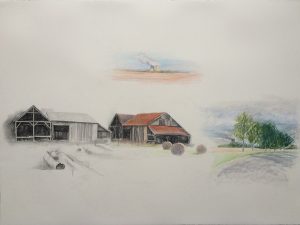Lessons and inspiration from an artist mom
By Patricia Moss-Vreeland
In all my years of training as an artist, both at the University of the Arts and Tyler School of Art, I can recall many gifted and inspiring teachers, but none gave me quite so solid a sense of passion and vocation as my mother. She was my first real teacher, and instilled in me the desire to make art and make this a way of life. Because of her, I believe I was able to appreciate two very different artist teachers—Jane Piper, for her very painterly sense of pictorial space, and Larry Day, for his intellectual approach.
In remembering my mother, I am forever grateful for the incredible gift of being able to get lost in something that has no apparent boundaries, that of making art and looking at art. This presented a different way of thinking about and responding to external stresses that tend to burden us or make one feel self-conscious, the feelings that flood us in so many other ways throughout a lifetime. Art can call us out with a feeling of freedom. And I have this woman, my mother, to thank for this.
From the age of three, I remember watching her draw and copy, and right before my eyes, a replica emerged. It was magical, and my first memory of pure joy. To my wonder, it soon became my own reality, as she quickly recognized my skill and fascination with drawing. My mother placed the pencil and brush in my hand and it became an extension ever since. She oversaw all of my drawings and paintings throughout my childhood, often giving me her help through critiques, and then slowly fading to just praising my efforts and sharing the satisfaction of seeing art emerge almost daily. Whenever my homework was done, out came the paper and pencil and a world opened up with so many possibilities. She was always excited to see whatever it was that I chose to work on, whether it was a pencil drawing, a pastel, or an oil painting. She presented to me early on the sheer pleasure of assembling objects that for her contained a story, and showed her love for making something from one’s imagination.
I grew up liking to play a part in this evolution of form, purely for it own sake. I liked watching, listening and making at the same time, and so did she. Together we found a deep kind of communication with each other over time through art, often visiting museums together as a counterpoint to drafting and painting. I was privileged to grow up in New York City, so we had many museums to visit and many ways to spend time together.
Because she was both companion and mentor—and my mother as well—I developed from an early age a certain braiding of art and love, which is an intrinsic part of who I am today. It became important that my drawings first spoke about things as suggestions, and I discovered they could translate emotions and feelings and break away from the world as a finite experience. I discovered that art was about process, ideas, inner movement, and creating a magical moment.
My mother, who was gifted in drafting, was also for a time a designer by profession. Looking back, she may also have been an early installation artist before there was even a term for that process. Arrangements could be made from an antique book, an inkwell, a netsuke, and a pair of spectacles. It was through these “set-ups” in her living spaces that I was inspired to begin as a still life artist after art school. These quiet groupings of hers in our living room, spoke to me more than the individual objects she collected. She was always creating set-ups of her objects that seemed to tell a story, and these arrangements changed whenever she felt like changing the story. Maybe she needed a new narrative, and a place to display information about shapes, colors, textures, and history too. I would quietly take my place to draw whatever it was she had put in front of me.
As I embarked on a professional life as an artist, sadly, my mother’s life was cut short with a diagnosis of cancer that came too late for treatment. She was thankfully there to meet my wonderful art dealer Marian Locks, and to see my work in a major exhibition at the Institute of Contemporary Art, Philadelphia. Her last wish was to sit with me in one of the many rooms we roamed through at the Metropolitan Museum of Art. Our favorites were the galleries containing the Vermeer’s and Rembrandt’s Aristotle with a Bust of Homer. I knew she was in pain, but we always could soak in the art and talk about it, and through the silence of it all, share being together as a lasting memory of art and love. Looking back on this time, she inspired me to continue in this path without her. The idea of home, being significant in so many ways throughout one’s life, expanded to these public spaces.
I have always felt sad that I never really thanked her for her own seriousness about art, and for generously transferring this attitude to me, once I showed the skill and passion, so that I could grow into the artist that she never did. My mother, as a great art teacher, inspired me, taught me, reveled in what I made and invented, and celebrated the professional validation I began to receive. She understood the power of art and its ability to communicate in unique ways with the world.
As my own work grows and continues to explore the function of memory, my process is reinforced by recollections of my mother’s early encouragement, love, and guidance.
Top: Patricia Moss-Vreeland, A Silence, oil on linen on gessoed Masonite, 16 by 20 inches




I greatly appreciate this essay, such a fine and touching remembrance and tribute to your mother and most important teacher.
I also resonate very deeply with it as my mother was so important and my growth and path as an artist .
Thank you
Thanks for your thoughtful and heartfelt comment. I’m happy this made such a connection to you and your mother as well.
Great article, my mother was also my most important role model, a great artist who followed the steps of my grand mother, one of the first woman to enter the Ecole des Beaux Arts de Paris with teacher Maurice Denis. I love these stories showing how serious have been women in art, while given so little attention.